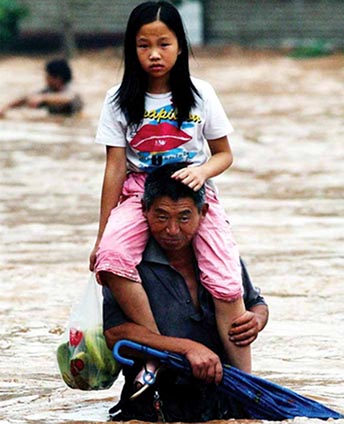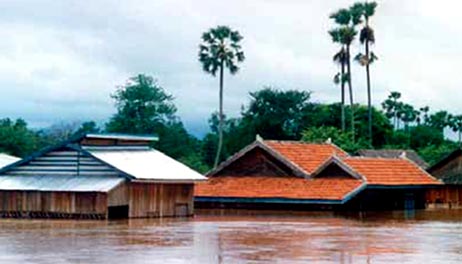A Chinese father and his daughter wade through flood waters in Jintang County, Chengdu, Sichuan Province, June 29, 2004. The lowlying county along the Yangtze River is frequently flooded by heavy rains during the summer

Every year, reports of large-scale flooding in the Asian lowlands capture headlines and dominate newscasts. The 1980s and 1990s will be particularly remembered for catastrophic floods and their profound effects on people, property and economies in many Asian countries.
Who doesn’t recall the flooding of the Yangtze River in 1998, which devastated large areas of central China and resulted in damage in excess of US$30 billion? Between January and August 2004, 46 million people were affected by floods in China. Floods in 2000 affected 3.5 million people in Cambodia (one-third of the population) and 5 million in Viet Nam, with associated costs of US$145 million and US$285 million, respectively. In the same year, floods in Bangladesh displaced more than 5 million people and in India 30 million. A single flood in 1999 in the small, central province of Thua Thien Hue, Viet Nam, led to the deaths of 400 people and damage to property worth US$120 million, or one-half of the province’s annual GDP. Nearly every country in the region has suffered the effects of catastrophic floods at one time or another. Globally, floods affect the personal and economic fortunes of more than 60 million people each year.
Much has been written about floods, their causes and impacts. Debate has been intense about how to prevent, mitigate and manage them. Each tragic event inevitably becomes a political issue. Political survival demands that politicians are seen as responding to each crisis in quick fashion. Thus, officials seek immediate answers and short-term solutions. In many countries, there is widespread belief - including among many foresters - that forests can prevent or reduce floods. Therefore, an immediate, frequently drawn conclusion is that floods occur because forests have been cleared or degraded. Hence it is but a small step to presume that the continuing deforestation of Asia’s watersheds is the cause of the misery brought to millions of people every year.
The reality, however, is that direct links between deforestation and floods are far from certain. Although the media attributes virtually every flood-related tragedy to human activities - particularly to agricultural expansion and timber harvesting (typically characterised by the press as ‘rampant illegal logging’ irrespective of legality or harvesting methods employed) - hydrological systems are so complex that it is extremely difficult to disentangle the impacts of land use from those of natural processes and phenomena.
In the case of upland/lowland as well as forest and flood relationships, existing ‘knowledge’ is frequently based more on perceived wisdom, or myths, than on science. In the rush to identify the culprits for the most recent disasters, assumptions are made about processes in one region based on observations from other regions which often have quite different environmental characteristics, or by extrapolating from small to large scales.
Oversimplification is common, frequently leading to initiatives such as logging bans or the resettlement of people residing in watershed areas - often with minimal environmental benefits but very definite negative social and economic implications. The unfortunate outcome is that intended results are rarely achieved, but scarce funds are misallocated and unnecessary hardships are heaped upon those segments of society that become scapegoats for flood-related disasters and damages.
All floods cannot and should not be completely prevented - flooding is important for maintaining biodiversity, fish stocks and fertility of floodplain soils. In many floodplains, certain crops (e.g., jute or deep water aman rice in Bangladesh) depend on seasonal flooding. However, steps can be taken to limit the adverse impacts of floods and to ensure effective responses to flooding events. This requires a far better understanding of the interactions between human activities and floods, the limitations of watershed management and the role of floodplain or river-basin management in reducing flood-related impacts.
As a first step, decision-making needs to be supported by an objective perspective of the relationships between forests and water, in order to distinguish myths and conventional wisdom from facts and sound science. Building on better understanding of physical processes and the relationships between land use and hydrology, more effective responses can be designed to reduce the magnitude of disasters without repeating the mistakes of the past.
Recent flood in Cambodia (courtesy of Mr Ty Sokhun, Forest Management Office, Department of Forestry and Wildlife, Cambodia through Water Resources Section, UNESCAP)
